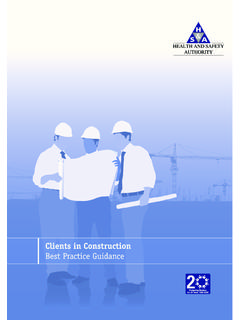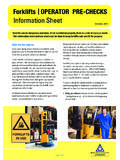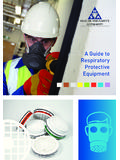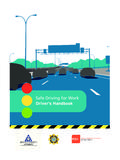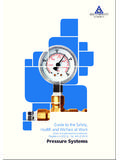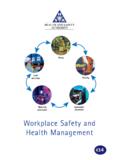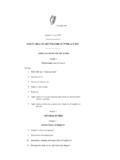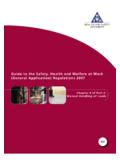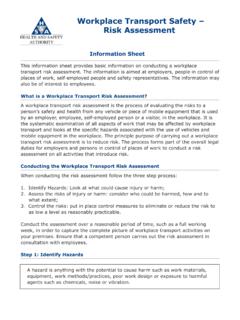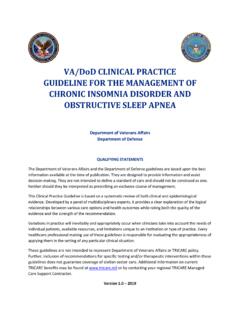Transcription of Guidance for Employers and Employees on Night and Shift …
1 Guidance forEmployers andEmployees onNight and Shift WorkPublished in September 2012 by the Health and Safety Authority, The Metropol-itan Building, James Joyce Street, Dublin 1. All rights reserved. No part of this publication may be reproduced, stored in a retrieval system, or transmitted in any form or by any means, electronic,mechanical, photocopying, recording or otherwise, without the prior permission of the Health and Safety vision: A national culture whereall commit to safe andhealthy workplaces and the safe and sustainablemanagement of chemicalsContentsAcknowledgement1. Introduction ..22. Background Information ..23. Effects of Night and ShiftWork .. Introduction .. Disruption of the internal body clock (circadian rhythms) .. difficulties .. Fatigue .. Health effects .. Individual factors .. Social and family factors .. Errors and accidents.
2 84. Risk Assessment .. Introduction .. Establish a system to manage the risks .. Assess the risks in yourworkplace .. Take action to reduce therisks .. Review arrangementsregularly ..215. Practical Advice for Employees .. Introduction .. Driving to and from work .. sleep pattern .. sleep environment .. Promoting sleep .. Diet .. Stimulants and sedatives .. Physical activity .. Social support .. Keeping alert at work ..266. Legal Requirements .. Legislation .. Organisation of WorkingTime Act 1997 .. Organisation of WorkingTime (General Exemptions)Regulations 1998 .. Safety, Health andWelfare at Work (GeneralApplication) Regulations2007, Chapter 3 of Part 6: Night Work and ShiftWork .. Regulation 151 of the Safety, Health and Welfare at Work (General Application) Regulations 2007, Chapter 2 of Part 6: Protection of Pregnant, Post Natal and Breastfeeding Employees .
3 Regulations 143 and 146 of the Safety, Health and Welfare at Work (General Application) Regulations 2007, Chapter 1 of Part 6: Protection of Children and Young Persons ..347. Shift Work Assessment Tools and Techniques .. List of Shift workassessment tools andtechniques ..358. Procedure for Night WorkerHealth Assessment .. Introduction .. Occupational Health Night worker health questionnaire .. Occupational Health Night worker health assessment questionnaire .. Occupational Health Night worker health assessment questionnaire review form ..409. Case Study ..41 Case A ..4110. Publications and Sources of Information .. Publications .. Sources of information ..442 Guidance for Employers and Employees on Night and Shift WorkThe Health & Safety AuthorityThe Health and Safety Authority (HSA) wishes to acknowledge the Health andSafety Executive s UK publication, Managing Shift work as a reference documentin parts of this IntroductionThe objective of this guide is to assist Employers and Employees and others to complywith health and safety legislation and in so doing to minimise any adverse effects ofnight and Shift work.
4 It is not intended as a legal interpretation of the guide will increase your understanding of Night and Shift work and itspotential impact on health and safety. It will describe measures Employers andemployees can take at work to reduce any adverse effects of Night or Shift will assist Employers in managing Night and Shift work so as to comply withthe legislation and to prevent fatigue and any associated illness arising in guide gives practical advice on carrying out risk assessments, Shift design and themaintenance of the work also gives Employees who carry out Shift and Night work advice on whatthey can do in relation to sleep and rest, health promotion, lifestyle, socialisation andfamily life in order to ensure a healthy and productive life. This guide should be read in conjunction with other legislation such as theOrganisation of Working Time Act 1997, and associated Background InformationToday an increasing number of workers do Shift and Night work as part of their workcontract.
5 There are a number of reasons for this and they include economies ofcontinuous production, business needs, the need to provide a 24 hour commercial oremergency service, work life balance, and and Night work are common in sectors such as: 24/7 emergency services ( ambulance, fire, hospital, police, prisons) 24/7 security services 24/7 utility services ( electricity, gas, water) 24/7 production ( chemicals, pharmaceuticals, manufacturing) Leisure and entertainment activities ( bars, hotels, concerts, discos) Night work to ensure early next day service delivery ( post, couriers, transport) Night work to ensure early next day product delivery ( bakery, newspapers) Work across different international time zones ( call centres, finance) Changing retail customer preferences ( 24/7 supermarkets, garages)The Health & Safety Authority3It is estimated that in Ireland approximately 15% or 270,000 of the working populationof million workers do Shift and Night work on a regular basis and it is likely that thistrend will increase over the coming years.
6 From the results of established evidence and reputable research it has becomewell known that Shift and Night work can lead to fatigue and other ill health effects andthese are described in Section 3. The main cause is the disruptions of circadianrhythm , which leads to fatigue. Our circadian rhythm basically keeps the body in tunewith daylight and Night time hours. We have a natural inclination to be active duringdaylight hours and to rest and sleep at Night when it is dark. The body clock is resistantto changes in this natural order of things. This is a reason why many find it hard tosleep during daylight hours after a Night Shift . There are many different types of Shift work, with variations in Shift duration,number of shifts, Shift rotation, rest periods between shifts and days off. The design ofa particular Shift pattern is a science in itself and will depend on many factors includingbusiness needs and the type of work being undertaken.
7 As with other workplacehazards, the most important thing is to carry out a risk assessment and implementcontrol measures to minimise any possible adverse effects arising from the particularshift pattern and work. Risk assessment and measures to minimise risk factors aredescribed in the tables in Section 4 of this Guidance . Shift workers themselves have abig role to play in promoting and maintaining their own health and Section 5 givespractical advice that will help them remain healthy. Council Directive 93/104/EC sought to minimise the adverse effects of bothexcessive hours of work and also Night and Shift work in the EU. Member Statesimplemented the provisions of this Directive in different ways. In England, the WorkingTime Regulations 1998 cover all these provisions. In contrast, in Ireland the Organisationof Working Time Act, 1997 stipulates maximum hours of work, minimum breaks anddays off while the original Safety, Health and Welfare at Work ( Night Work and ShiftWork) Regulations 2000 were transposed into the Safety, Health and Welfare at Work(General Application) Regulations 2007 and deal specifically with Night and Shift and other relevant legal provisions are outlined in Section 6 of this is a requirement in the Night Work and Shift Work Regulations for Employers tocarry out a Night worker health assessment and an example of one is outlined in Section are a number of well established Shift work assessment tools which canassist in identifying whether your existing Shift schedule is likely to be causing fatiguein your workplace (see Section 7)
8 And an actual case study is described in Section useful associated publications and sources of information are included in Section for Employers and Employees on Night and Shift WorkThe Health & Safety Authority3. Effects of Night and Shift IntroductionThere is a considerable body of research evidence regarding the negative effects ofnight and Shift work. These effects include: Disruption of the internal body clock (circadian rhythms) Sleeping difficulties Fatigue Health effects Individual factors Social and family factors Errors and accidents These effects obviously do not happen to all Night and Shift workers and with propermanagement the risks can be minimised. Fatigue is the main issue which needs to Disruption of the internal body clock (circadian rhythms) Biological clocksA master clock in the brain coordinates the various body biological clocks so that theyare in synch.
9 The biological clocks in turn drive our circadian rhythms. The master clockconsists of a group of nerve endings called the suprachiasmatic nucleus (SCN), whichis located in the hypothalamus area of the brain close to the optic Circadian rhythmsCircadian rhythms are physical, mental and behavioural changes that follow roughly awhole day or twenty four hour cycle. Circadian rhythms are produced by natural factorsin the body such as genetic activity and the release of the hormone melatonin, butthey are also affected by signals from the environment, especially light. Light is themain cue influencing circadian rhythms, turning on and off genes that control theinternal clocks. Circadian rhythms can change sleep -wake cycles, hormone release,body temperature and other important bodily rhythms are important in determining human sleep patterns. Thebody s master clock or SCN controls the production of melatonin that makes us it is located just above the optic nerves, which relay information from the eyes(external environment) to the brain, the SCN receives information about incoming , there is less light, such as at Night or in darkness, the SCN directs the brain toproduce more melatonin, so you get drowsy or , which is vital to the suppression of tumours, is released at Health & Safety Authority5 Light shuts down melatonin production, so being exposed to artificial light at nightcould lead to a melatonin of the circadian rhythm is linked to various sleep disorders such asinsomnia, disrupted sleep -wake cycles and insufficient hours of sleep .
10 Disruptedcircadian rhythms are also associated with depression, bipolar disorder and seasonalaffective and Shift work can cause disruption to the circadian rhythms. Basicallyif you are working at Night , you are not sleeping when your body tells you should when you try to go to sleep during the day it is not easy as the circadianrhythm is telling you that you should be awake and this is supported by cues such asdaylight and normal daytime external environmental activities such as traffic and noise,which make it more difficult to internal body clocks can change gradually but are resistant to abruptchanges brought on by Night and Shift work. Nor will they ever fully adjust, even forthose workers on permanent Night shifts. Such workers may sleep during the day whenthey are on their rest period between shifts but on days off their body clocks willattempt to reset to normal circadian end result of disruption of the circadian rhythms is loss of sleep anddisturbed sleep , which both lead to fatigue.
